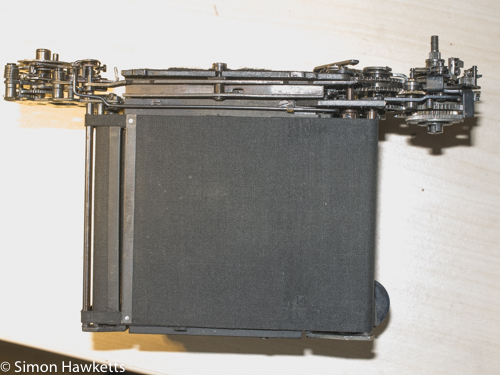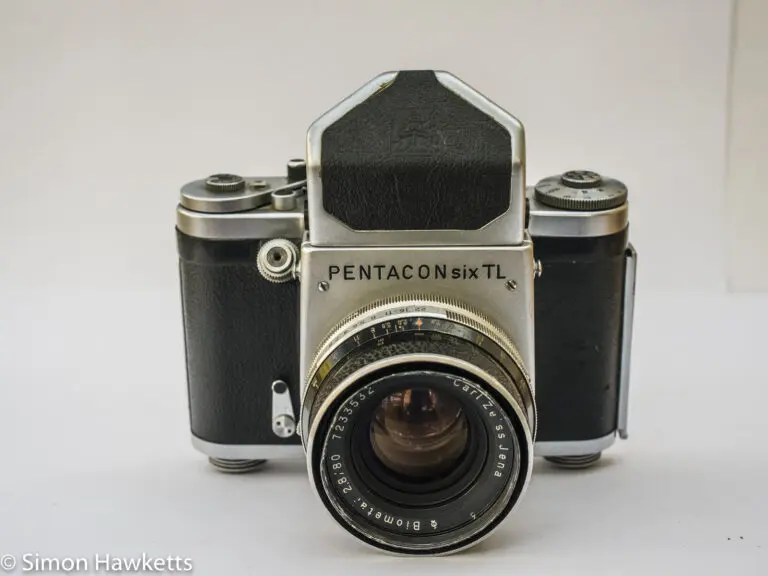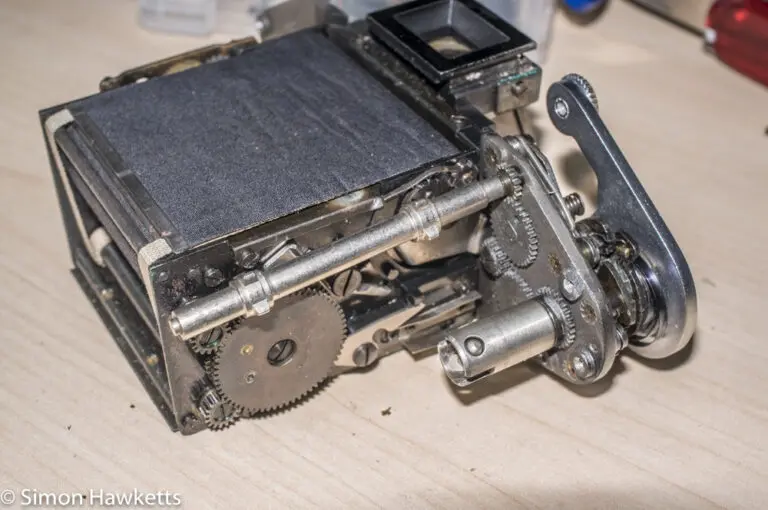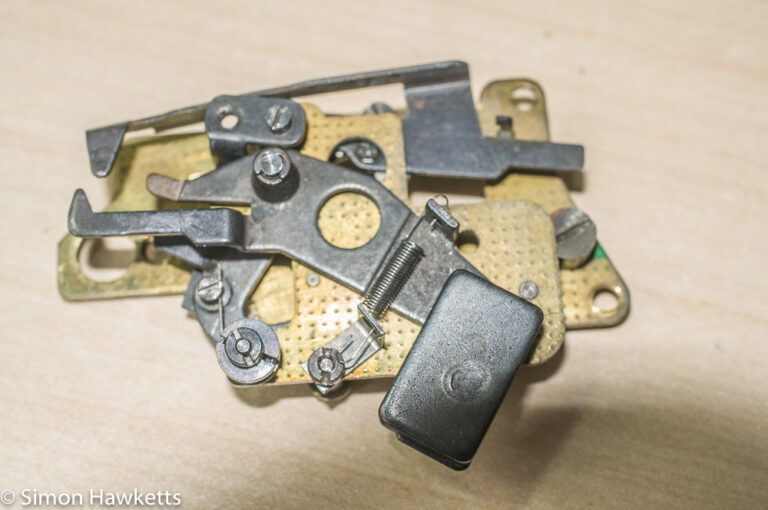Pentacon six project – Step 3, Pentacon Six shutter assembly
This is the third post in my Pentacon Six project and follows on from my last one where I removed the shutter from the chassis and carried out a bit of a clean and lubrication. Since then, I’ve had a look at the Pentacon Six shutter assembly, and I’ve come to a few conclusions/observations.
Pentacon six shutter observations
For a start, I was surprised at how flimsy the shutter assembly is when out of the chassis. The plate that the film advance assembly fits on is just bolted onto the rest of the frame with a single screw on one side and a couple of screws into the side of the chassis next to the shutter release, and there doesn’t seem to be a lot of overlap of the two pieces. This plate seems to wobble all over the place and worryingly the single screw at the front which holds it only has half a head, so I’m sure it will break at some point. To be fair, I suppose the shutter was not designed to be handled outside the chassis.
This could be a reason I managed to get the shutter blinds to move without the mirror – it’s possible some levers are out of alignment when the whole unit isn’t fitted in the chassis.
For the purposes of trying to understand what is happening, I thought it would be useful to think of the sequence of events which take place when the camera is used. So I came up with this list of actions which happen from the point the photographer decides to take a picture (ignoring the shutter speed and aperture setting)
- The film advance is wound. This one action needs to
- Advance the film by one frame.
- Advance the frame counter by one.
- Wind down the mirror so the image from the lens is reflected up to the focus screen.
- Put in place the latch which holds the mirror in the down position.
- Move the shutter blinds to their correct position.
- Move the aperture actuation lever forward to open up the lens aperture.
- The shutter release is pressed. This one action needs to
- Release the mirror so the image from the lens is diverted to the film plane
- Move the aperture lever back so the lens is stopped down (this could happen before the mirror moves)
- Release the first shutter curtain so it starts it’s travel across the film
- Close the contacts on the flash sync socket
- At the correct time release the second curtain so it travels across the film plane and closes the shutter
What I need to do is see how each of these actions is accomplished on the Pentacon Six, and that will help me to understand how to fix and set up my shutter assembly.
Until I wrote the list above I had never really thought in detail about the sequence of events which take place when the shutter release button is pressed, I had simply assumed that pressing the button initiated the release of the shutter blinds.
Now I’ve looked in more detail, I can see that the shutter release button doesn’t actually fire the shutter – or at least the shutter blinds moving are not the initial movement of the shutter firing. In fact the shutter button releases the mirror, and as the mirror flips up it diverts a lever which actually fires the shutter. It’s one of those things which are obvious once you realise it because if the shutter fired first on fast shutter speeds it’s likely the top of the image would be obscured by the mirror.
I think this may also be part of the explanation of how I got the shutter out of sequence – I think possibly I somehow managed to fire the shutter blinds rather than releasing the mirror.
Although I am pretty sure this is how it works, I can’t see the connection between the shutter release button and the release of the mirror because the whole of that side is blocked by the second curtain roll. Another consequence of the shutter being ‘out of sync’ is that the arm which pushes the aperture pin on the lens is stuck in the pushed out position, resulting in the shutter assembly not actually being able to fit into the opening in the chassis which it came out of.
So going by the list above, these are my findings on how the Pentacon Six achieves the actions required from the film advance and the shutter release.
Please note that some of this information comes from Rick Oleson who very kindly sent me his notes on setting shutter speeds and general repair and setup on the Pentacon Six. Rick’s site, which has a huge amount of very useful information on the Pentacon Six and other classic cameras, is http://rick_oleson.tripod.com.
I also found the original Pentacon Six technical manual on a website which also provided some useful information.
Film Advance
Advance the film by one frame
This one is relatively easy.
The top of the film take up spool is driven directly by the film wheel on the bottom of the film advance spindle. As the film advance lever is turned, it directly turns the take-up spool and pulls the film across the film gate.
There is also a toothed roller which grips into the film to help pull it across, which is driven directly by the film advance cog. It is this roller which is used to ensure the frame spacing is correct – apparently another potential problem with the Pentacon Six.
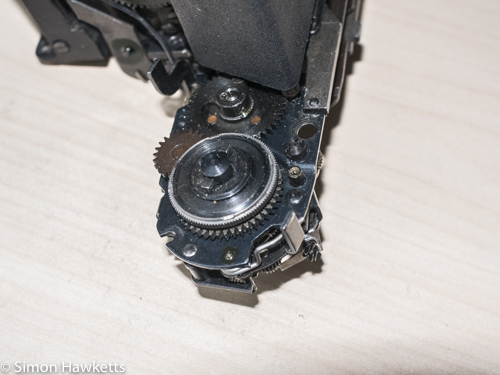
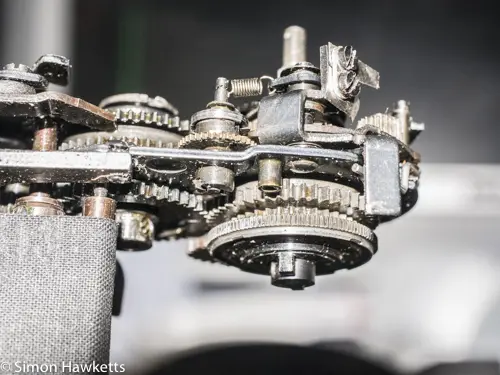
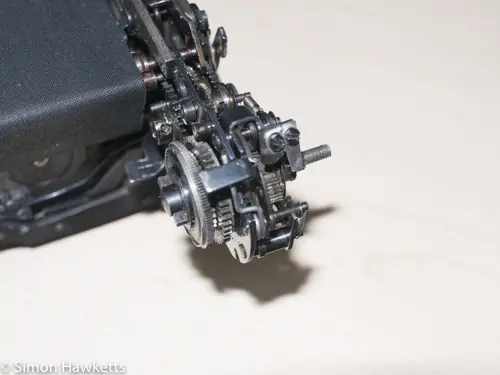
Advance the frame counter by one
The frame counter is, as far as I can see, entirely contained in the film advance lever mechanism on the top plate of the camera – at least I don’t think there is anything which I would need to do to make it work correctly other than re-assemble the top plate correctly.
Wind down the mirror and latch it
The mirror is wound down by a set of gears which transfer the rotational movement of the frame advance lever into a rotational movement at 90deg to the frame advance. This is shown in the pictures below. It’s a little difficult to see because the second curtain is in the way, but you can just about make it out. These gears are underneath the frame advance spindle. I think the view in the film chamber shows the latch which holds the mirror until release.


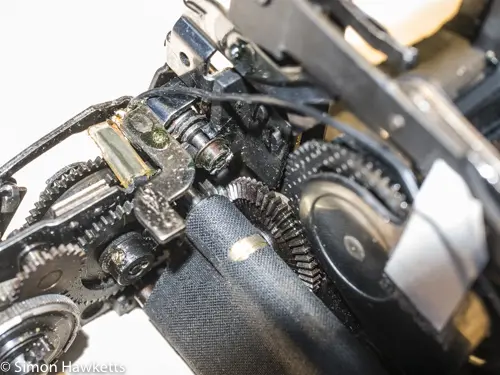
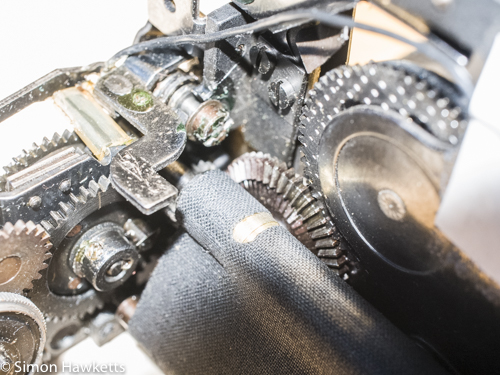
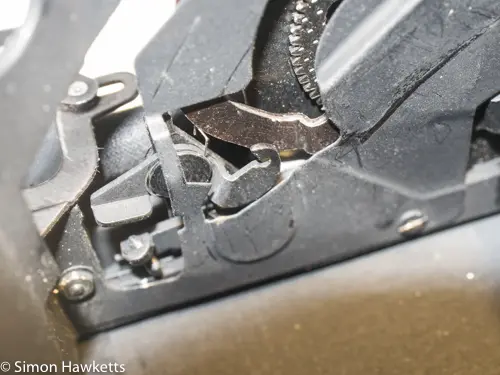
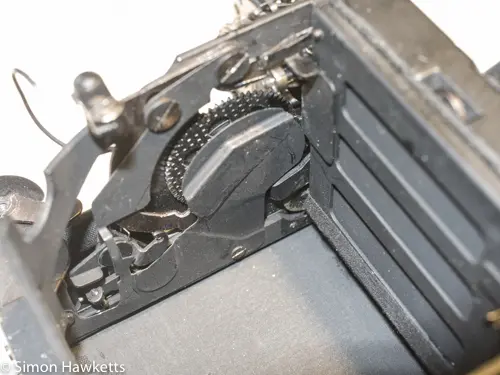
Move the shutter blinds to their correct position
The shutter blinds are moved by a couple of spindles mounted on a movable plate at the top left of the frame advance side of the shutter assembly (on the left, with the shutter facing you and the ‘lens end’ pointing away from you).
These are difficult to see, but you can make out the first curtain drive in the centre of the first picture, with the brass coloured spindle underneath. When the curtain is fully across the frame and in the ‘cocked’ position, a latch which is part of the release mechanism holds them in place. The second picture shows the plate which the drive wheels are mounted on, and this can be loosened and moved back to dis-engage the shutter curtains from the cocking mechanism in order to set the correct curtain start position.
I think I will need to do this because as a consequence of the shutter ‘hiccup’ the shutter blinds are now in completely the wrong position when the shutter is cocked. In Rick’s notes, he says it’s important to make sure the shutter positions are correct, so I will set the positions and then use his notes to set the shutter speeds.
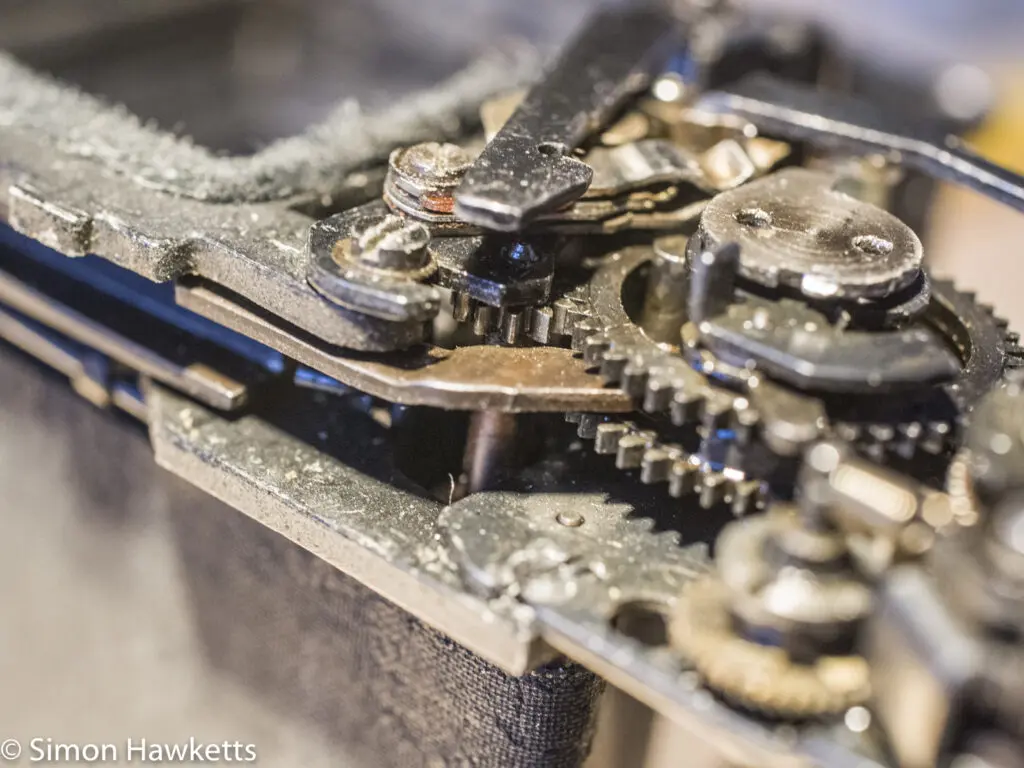
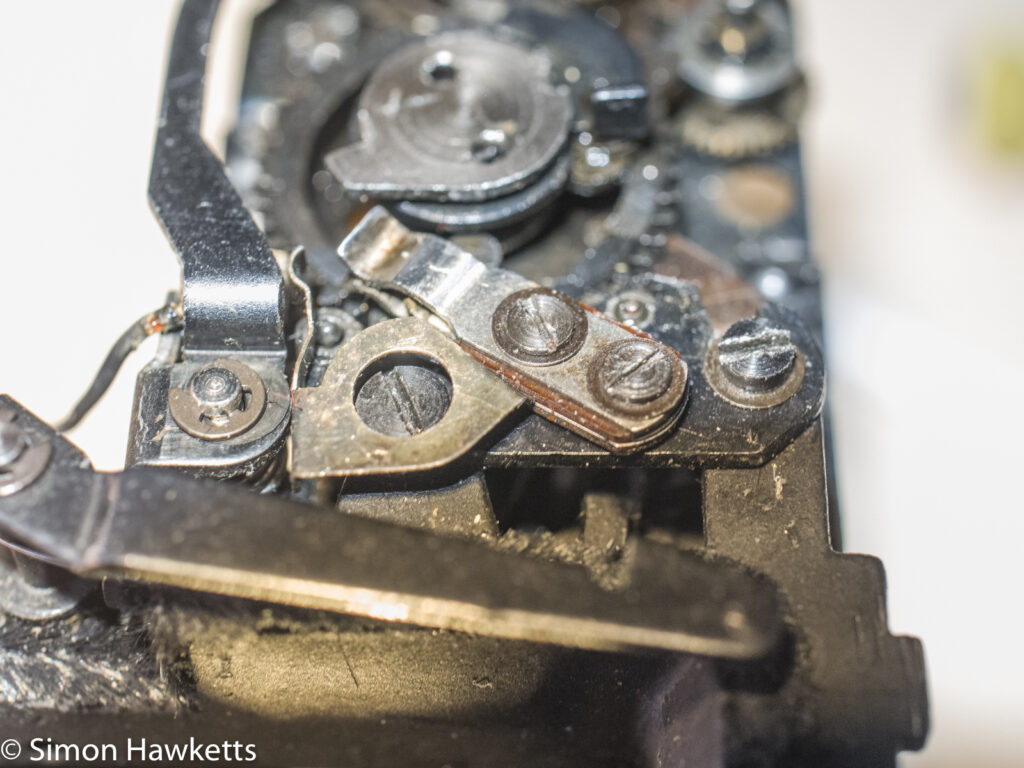
Move the aperture actuation lever
The aperture actuation lever is connected to the same mechanism which winds the mirror down, but is hidden from view.
Shutter Release
Release the mirror
I can’t see the action which results in the mirror being released because it’s hidden within the body of the shutter assembly behind the curtain rollers. As I said above, I’m pretty sure this is the first action of the shutter release button. The picture below shows the brakes which are used to gently stop the mirror towards the end of its travel back up to the top of the camera body.
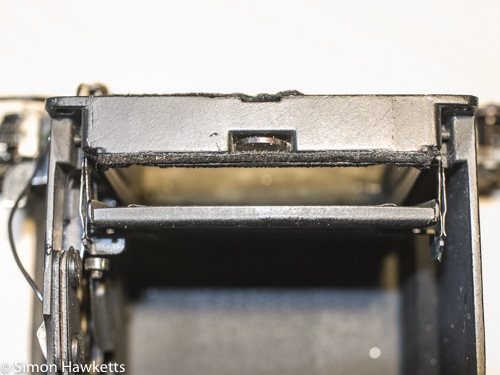
Move the aperture pin back.
The bar which moves the aperture pin forward and back is connected to the gear which winds the mirror up and down. This is all hidden by the plate on the inside of the camera, so I can’t examine it, but I can see that as the mirror springs up the arm pulls back.
Start the shutter blinds movement.
The initiation of the shutter blind movement is caused by a lever which is moved by the mirror on its travel back to the top of the film chamber. This lever is pivoted at the top of the shutter and forms the latch which holds the shutter blinds in place when the shutter is cocked. I can see that there are brakes which stop the curtains as they get close to the end of their travel.
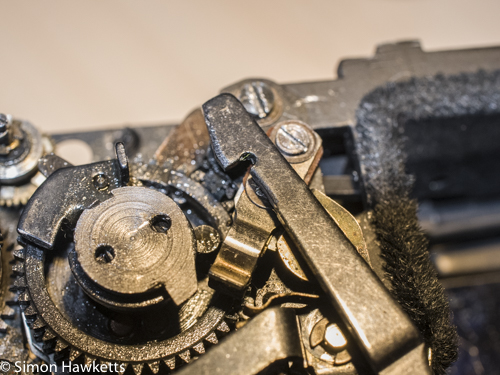
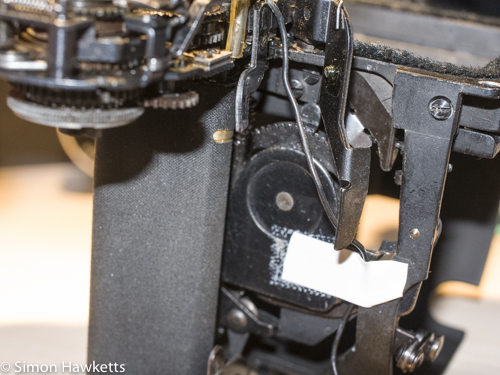
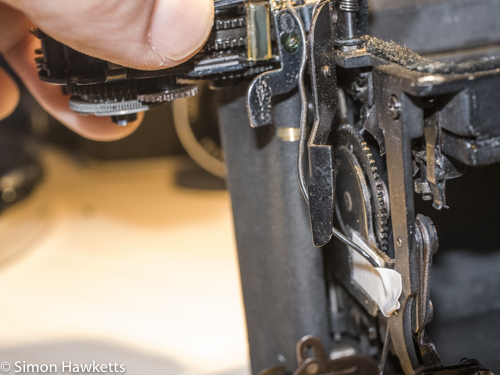

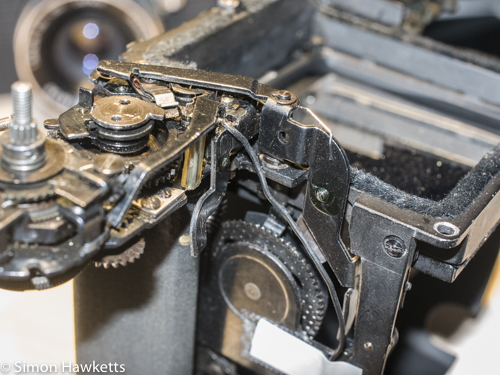
Close the contacts on the flash sync socket
This is something I haven’t yet worked out yet, but I don’t think it’s too important in terms of getting the shutter assembly working correctly.
Next steps.
So I have a bit better knowledge of the sequence of events that leads to a cocked shutter and what happens when the shutter release is pressed. The shutter however is in a pretty poor state, and I’m not completely sure that it is possible to recover it. I’m particularly worried about the single damaged screw which holds the film advance plate to the rest of the shutter assembly because I’m sure any stress placed on it will result in it shearing off. Unfortunately, I don’t think I can remove the screw and replace it without losing the alignment between the two pieces.
However, nothing ventured, nothing gained, so I’m going to have a go at setting the shutter blind gap and re-tension the blinds to see if I can at least get it working. If nothing else, I may as well get experience of setting everything up on this shutter and see if I can find another Pentacon Six with a better shutter but more tatty body to act as a donor.
If I can make the sequence work and get close to the correct operation, my next task is to work out a method of timing the shutter (I have an idea to do that with a Raspberry Pi, a light sensor module and a few lines of Python. Watch this space)
After that I will need to decide if I have to replace the whole unit or if I can drill the plate and add another screw to strengthen it. It may also be that if I could clamp the two plates, I could just remove and replace the screw.
There then remains the issue of the curtain with light leak, which I may have to replace, or possibly I could get away with patching the current curtains. Of course the chassis itself can be worked on while I’m still trying to get the shutter unit working, so I’m in the process of cleaning that and replacing the light seals and also trying to find some nice material to replace the cover.
Discover more from Everything Vintage
Subscribe to get the latest posts sent to your email.

